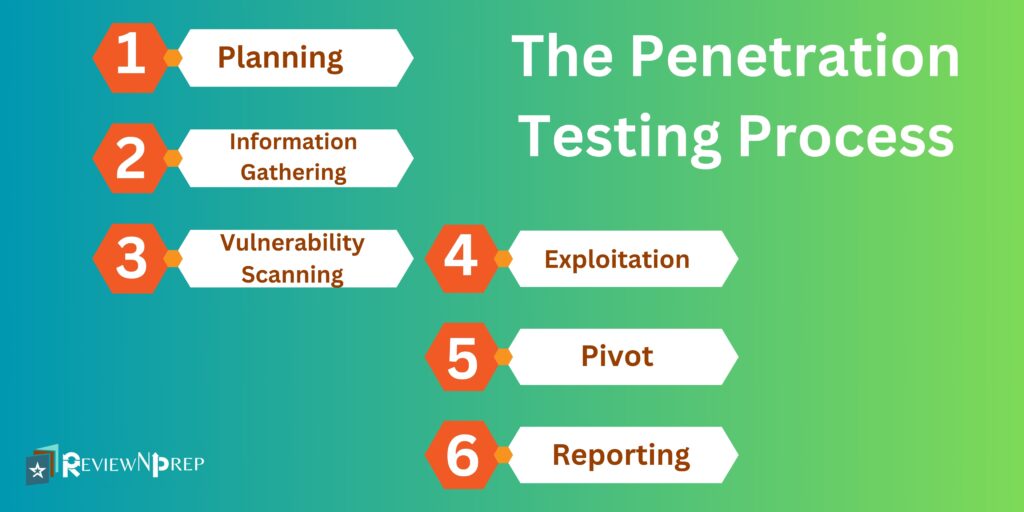|
|
In today’s hyper-connected digital world, organizations, both large and small, face a constant threat from malicious actors seeking to exploit security weaknesses in their systems. To combat this, the role of the security team has become paramount. One essential tool in their arsenal is penetration testing.
But how exactly does pen testing work to bolster security?
In this blog, we will delve into how penetration testing functions in cybersecurity, explore its types, and offer real-life examples of why it’s a critical security measure.
Table of Contents
What is Penetration Testing?
Penetration testing, or pen testing, is a proactive and methodical approach to assess the security infrastructure of an organization. It aims to discover potential vulnerabilities and security weaknesses that could be exploited by malicious actors.
Ethical hackers, known as penetration testers or pen testers, mimic the techniques used by real attackers without causing any harm to the system and networks. These individuals identify weak spots and flaws which are then fixed by the respective technology teams.
Why is Pen Testing Important?
There are several key reasons organizations utilize penetration testing services:
- Find exploitable vulnerabilities – Pen tests proactively detect areas where systems and networks are susceptible to compromise, like unpatched software, misconfigurations, or inadequate access controls.
- Improve security posture – The findings from pen tests allow security teams to improve defenses by patching vulnerabilities and tightening controls before systems can be breached.
- Meet compliance requirements – Standards like PCI DSS, GDPR, HIPAA require penetration testing to meet compliance obligations. Tests provide evidence of diligence.
- Assess team response – Tests evaluate how quickly and effectively staff detect and respond to attacks. This allows improving incident response plans.
- Protecting customer data – No one wants their data to be exploited and sold on to the dark web. Pen testing proactively helps companies take an action to remediate these security vulnerabilities.
- Justify security spending – Demonstrating vulnerabilities through testing provides hard data to justify security projects and purchases to leadership.
Real-World Pen Test Outcomes
Skilled pen testers frequently uncover serious vulnerabilities that could lead to disastrous breaches if left unaddressed. Here are some real-world examples:
- Gained access to a healthcare network through an unpatched VPN server, exposing protected health records.
- Retrieved thousands of user credentials and credit card numbers through SQL injection on an ecommerce site.
- Compromised employee accounts through password spraying to infiltrate a financial firm’s accounting application.
- Moved laterally from a phishing attack on a user to gain domain admin privileges on a corporate network.
These simulated attacks prompted the affected organizations to take corrective actions like patching, tighter access controls, and better staff training.
What are the Types of Penetration Testing?
There are different types of penetration testing designed to address various security issues:
- External Penetration Testing: This simulates a real attack on an organization’s network from the outside, targeting systems, IP addresses, and wireless networks.
- Internal Penetration Testing: It focuses on assessing the security measures within an organization’s internal network infrastructure, identifying weak spots and vulnerabilities that an attacker with unauthorized access could exploit.
- Social Engineering Attacks: Penetration testers use social engineering techniques to assess an organization’s susceptibility to manipulation, such as phishing attacks or impersonation.
The Penetration Testing Process

Penetration tests follow a systematic methodology while simulating real-world attack techniques:
Planning – Scope out the specific systems, networks, and applications to be tested. Identify what kinds of attacks will be simulated.
Information Gathering – Gather data about the target environment through open source research and reconnaissance.
Vulnerability Scanning – Scan for known software flaws and misconfigurations that may be exploitable.
Exploitation – Attempt to penetrate systems by exploiting known vulnerabilities. Try injection attacks, password cracking, etc.
Pivot – Once initial access is gained, move through the internal network to find high-value systems.
Reporting – Document all findings, vulnerabilities, compromised data, and recommended remediation.
The Importance of Penetration Testing Reports
Penetration testing reports provide a detailed account of the assessment, including identified vulnerabilities and potential exploits. They guide organizations in taking remedial action to enhance their security infrastructure.
It’s crucial that reports are clear and concise, with actionable recommendations to fix security flaws.
Final Thoughts: Combining Pen Testing and Cybersecurity Best Practices
In a world where security issues are increasingly complex, penetration testing stands as a powerful shield against real-world attacks. By revealing exploitable vulnerabilities and weak spots, it empowers organizations to fortify their security controls.
Security experts, in collaboration with ethical hackers, help maintain a robust security posture, keeping organizations safe from persistent threats and potential vulnerabilities. As the digital landscape evolves, penetration testing remains an invaluable tool to safeguard against malicious actors and ensure the continued integrity of data and systems.
Organizations also need to incorporate security best practices like robust access controls, data encryption, security awareness training, and up-to-date defenses. Remember, security is an ongoing process.
Regular penetration testing is an essential part of your security strategy, guarding your organization against threats that are ever-evolving. Combining pen testing assessments with diligent security measures provides layered protection against real-world attacks.
Further Reading:
Mastering the Cybersecurity Job Search: Resume Tips and Beyond
Cybersecurity is everyone’s responsibility in an organization. Check out this blog to learn more.

